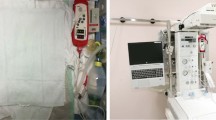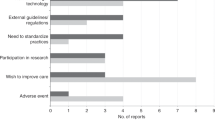Abstract
Background
The goal of every medical team is to provide optimal care for their patients. We aimed to use video review (VR) sessions to identify and address areas for improvement in neonatal care.
Methods
For nine months, neonatal procedures (stabilization at birth, intubations and sterile line insertions) were video recorded and reviewed with the neonatal care providers. Action research was used to identify and address areas for improvement which were categorized as (1) protocol/equipment adjustments, (2) input for research, (3) aspects of variety, or (4) development of educational material or training programs.
Results
Eighteen VR sessions were organized with a mean(SD) of 17(5) staff members participating. In total, 120 areas for improvement were identified and addressed, of which 84/120 (70%) were categorized as aspects of variety, 20/120 (17%) as development of educational material or training programs, 10/120 (8%) as protocol/equipment adjustments, and 6/120 (5%) as input for research. The areas for improvement were grouped in themes per category, including sterility, technique, equipment, communication, teamwork, parents’ perspective and ventilation.
Conclusion
Our study showed that regularly organized VR empowered healthcare providers to identify and address a large variety of areas for improvement, contributing to continuous learning and improvement processes.
Impact
-
Video review empowered healthcare providers to identify areas for improvement in neonatal care
-
Video review gave providers the opportunity to address identified areas for improvement, either by enhancing the application of external evidence (i.e. guidelines), learning from individual clinical expertise or strengthening resilience and teamwork
-
Embedding regularly organized video review sessions allowed for continuous monitoring of care by providers, which can be beneficial for creating ongoing learning and improvement processes
-
The structured pathways, supporting implementation of changes that were proposed based on the video review sessions, could help other centers make use of the potential video review has to offer
This is a preview of subscription content, access via your institution
Access options
Subscribe to this journal
Receive 14 print issues and online access
$259.00 per year
only $18.50 per issue
Buy this article
- Purchase on Springer Link
- Instant access to full article PDF
Prices may be subject to local taxes which are calculated during checkout




Similar content being viewed by others
Data availability
All data generated during and/or analyzed during the current study are available from the corresponding author on reasonable request.
References
Simma, B. et al. Video recording in the delivery room: Current status, implications and implementation. Pediatr. Res. https://doi.org/10.1038/s41390-021-01865-0 (2021).
Brogaard, L. & Uldbjerg, N. Filming for auditing of real-life emergency teams: A systematic review. BMJ Open Qual. 8, e000588 (2019).
Schilleman, K. et al. Auditing resuscitation of preterm infants at birth by recording video and physiological parameters. Resuscitation 83, 1135–1139 (2012).
van Vonderen, J. J. et al. Cardiorespiratory monitoring during neonatal resuscitation for direct feedback and audit. Front Pediatr. 4, 38 (2016).
Ritchie, P. D. & Cameron, P. A. An evaluation of trauma team leader performance by video recording. Aust. N. Z. J. Surg. 69, 183–186 (1999).
Oakley, E., Stocker, S., Staubli, G. & Young, S. Using video recording to identify management errors in pediatric trauma resuscitation. Pediatrics 117, 658–664 (2006).
Gonsalves, B. & Paller, K. A. Mistaken memories: Remembering events that never happened. Neuroscientist 8, 391–395 (2002).
Erdelyi, M. H. The ups and downs of memory. Am. Psychol. 65, 623–633 (2010).
Schilleman, K. et al. Auditing documentation on delivery room management using video and physiological recordings. Arch. Dis. Child Fetal Neonatal Ed. 99, F485–490 (2014).
McHugh, S., Sheard, L., O’Hara, J. & Lawton, R. The feasibility and acceptability of implementing video reflexive ethnography (Vre) as an improvement tool in acute maternity services. BMC Health Serv. Res. 22, 1–13 (2022).
Skåre, C. et al. Implementation and effectiveness of a video-based debriefing programme for neonatal resuscitation. Acta Anaesthesiol. Scand. 62, 394–403 (2018).
Couper, K. & Abella, B. S. Auditing resuscitation performance: Innovating to improve practice. Resuscitation 83, 1179–1180 (2012).
den Boer, M. C. et al. Improving the quality of provided care: Lessons learned from auditing neonatal stabilization. Front Pediatr. 8, 560 (2020).
Health, C. f. P. & Society. No Evidence without Context. About the Illusion of Evidence‐Based Practice in Healthcare. (2017).
Tawfik, D. S., Sexton, J. B., Adair, K. C., Kaplan, H. C. & Profit, J. Context in quality of care: Improving teamwork and resilience. Clin. Perinatol. 44, 541–552 (2017).
Hollnagel, E., Wears, R. L. & Braithwaite, J. From Safety-I to Safety-Ii: A White Paper. The resilient health care net: published simultaneously by the University of Southern Denmark, University of Florida, USA, and Macquarie University, Australia (2015).
Iedema, R. Creating safety by strengthening clinicians’ capacity for reflexivity. BMJ Qual. Saf. 20, i83–i86 (2011).
Suresh, G. et al. Voluntary anonymous reporting of medical errors for neonatal intensive care. Pediatrics 113, 1609–1618 (2004).
Thomas, E. J. et al. Teamwork and quality during neonatal care in the delivery room. J. Perinatol. 26, 163–169 (2006).
Cordeiro, L. & Soares, C. B. Action research in the healthcare field: A scoping review. JBI Database Syst. Rev. Implement Rep. 16, 1003–1047 (2018).
Van Heerden, C., Janse van Rensburg, E. S. & Maree, C. Action research as sustainable healthcare quality improvement: Advances in neonatal care emphasising collaboration, communication and empowerment. Action Res. 19, 710–727 (2021).
Van Heerden, C., Maree, C. & Janse van Rensburg, E. S. Strategies to sustain a quality improvement initiative in neonatal resuscitation. Afr. J. Prim. Health Care Fam. Med 8, e1–e10 (2016).
Migchelbrink, F. Actieonderzoek Voor Professionals in Zorg En Welzijn (Fontys, 2007).
Taylor, M. J. et al. Systematic review of the application of the plan-do-study-act method to improve quality in healthcare. BMJ Qual. Saf. 23, 290–298 (2014).
Baum, F., MacDougall, C. & Smith, D. Participatory action research. J. Epidemiol. Community Health 60, 854–857 (2006).
Hsieh, H.-F. & Shannon, S. E. Three approaches to qualitative content analysis. Qual. Health Res. 15, 1277–1288 (2005).
Reynolds, R., Pilcher, J., Ring, A., Johnson, R. & McKinley, P. The golden hour: Care of the Lbw infant during the first hour of life one unit’s experience. Neonatal Netw. 28, 211–219 (2009).
Biban, P., Marlow, N., Te Pas, A. B., Fanaroff, A. A. & Jobe, A. H. Advances in neonatal critical care: Pushing at the boundaries and connecting to long-term outcomes. Crit. Care Med. 49, 2003–2016 (2021).
Root, L. et al. Improving guideline compliance and documentation through auditing neonatal resuscitation. Front Pediatr. 7, 294 (2019).
Lubbert, P. H., Kaasschieter, E. G., Hoorntje, L. E. & Leenen, L. P. Video registration of trauma team performance in the emergency department: The results of a 2-year analysis in a level 1 trauma center. J. Trauma 67, 1412–1420 (2009).
Brogaard, L. et al. Teamwork and adherence to guideline on newborn resuscitation—video review of neonatal interdisciplinary teams. Front. Pediatrics 10, 828297 (2022).
Hoyt, D. B. et al. Video recording trauma resuscitations: An effective teaching technique. J. Trauma 28, 435–440 (1988).
Williams, A. L., Lasky, R. E., Dannemiller, J. L., Andrei, A. M. & Thomas, E. J. Teamwork behaviours and errors during neonatal resuscitation. Qual. Saf. Health Care 19, 60–64 (2010).
Bosk, C. L., Dixon-Woods, M., Goeschel, C. A. & Pronovost, P. J. Reality check for checklists. Lancet 374, 444–445 (2009).
Yamada, N., Kamlin, C. & Halamek, L. in Seminars in fetal and neonatal medicine. 306-311 (Elsevier).
Lane, B., Finer, N. & Rich, W. Duration of intubation attempts during neonatal resuscitation. J. Pediatr. 145, 67–70 (2004).
Leone, T. A. Using video to assess and improve patient safety during simulated and actual neonatal resuscitation. Semin Perinatol. 43, 151179 (2019).
Makary, M. A. The power of video recording: taking quality to the next level. JAMA 309, 1591–1592 (2013).
Gergen, K. J. Action research and orders of democracy. Action Res. 1, 39–56 (2003).
Soh, K. L., Davidson, P. M., Leslie, G. & Bin Abdul Rahman, A. Action research studies in the intensive care setting: A systematic review. Int. J. Nurs. Stud. 48, 258–268 (2011).
Zebuhr, C. et al. Evaluation of quantitative debriefing after pediatric cardiac arrest. Resuscitation 83, 1124–1128 (2012).
Baggs, J. G. et al. Association between nurse-physician collaboration and patient outcomes in three intensive care units. Crit. Care Med. 27, 1991–1998 (1999).
Awad, S. S. et al. Bridging the communication gap in the operating room with medical team training. Am. J. Surg. 190, 770–774 (2005).
Kemmis, S., McTaggart, R. & Nixon, R. (Springer, 2014).
McKay, K. J., Shaban, R. Z. & Ferguson, P. Hand hygiene compliance monitoring: do video-based technologies offer opportunities for the future? Infect. Dis. Health 25, 92–100 (2020).
Gupta, M., Soll, R. & Suresh, G. in Seminars in Perinatology. 151173 (Elsevier).
Acknowledgements
We acknowledge the support of the NICU team for participating in the Neoflix sessions.
Funding
A.B.teP. is a recipient of a ZonMw Safety-II grant (projectnr: 10130022010001).
Author information
Authors and Affiliations
Contributions
All authors contributed to the organization of the VR sessions and the performance of action research. AtP, RW and VH designed the study. Data collection and analysis were performed by VH and RW. The first draft of the manuscript was written by VH and RW and all authors read and approved the final manuscript and agree to be accountable for all aspects of the work.
Corresponding author
Ethics declarations
Competing interests
The authors declare no competing interests.
Consent to participate
The data of this study consists of the observations of the VR sessions and the following action research only. Additionally, verbal consent was obtained from the neonatal healthcare providers before an intervention would be recorded and used for a VR session. The recordings used for the VR sessions were part of standard care and used for quality assurance purposes only so patient consent was not sought. However, if parents were visible in a recording, they were asked for consent for use of the video in the VR session.
Additional information
Publisher’s note Springer Nature remains neutral with regard to jurisdictional claims in published maps and institutional affiliations.
Rights and permissions
Springer Nature or its licensor (e.g. a society or other partner) holds exclusive rights to this article under a publishing agreement with the author(s) or other rightsholder(s); author self-archiving of the accepted manuscript version of this article is solely governed by the terms of such publishing agreement and applicable law.
About this article
Cite this article
Heesters, V., van Zanten, H.A., Heijstek, V. et al. Record, reflect and refine: using video review as an initiative to improve neonatal care. Pediatr Res (2024). https://doi.org/10.1038/s41390-024-03083-w
Received:
Revised:
Accepted:
Published:
DOI: https://doi.org/10.1038/s41390-024-03083-w



